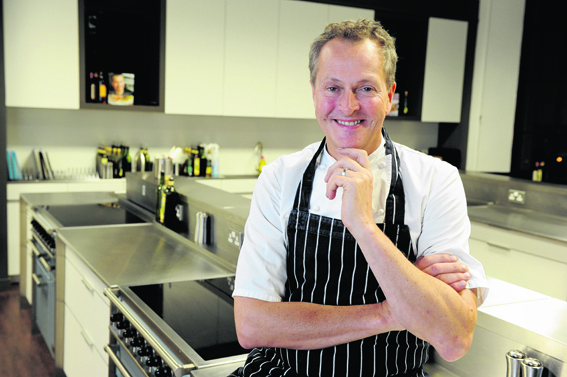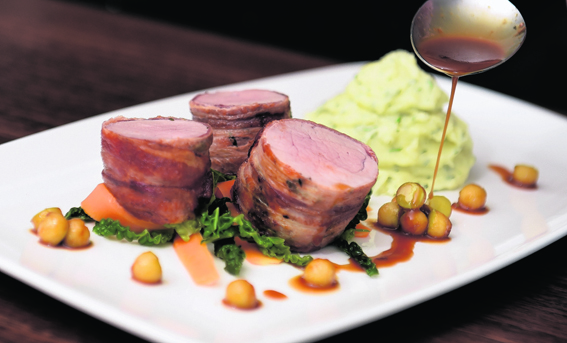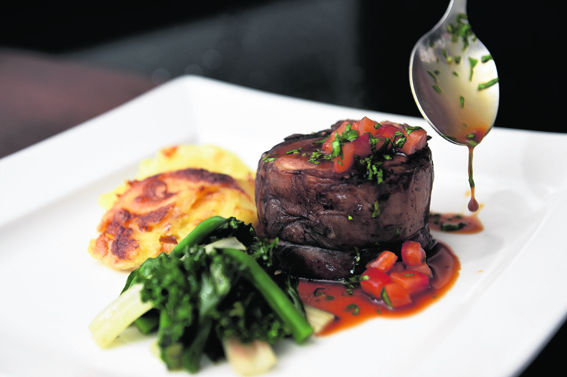Good Scottish pork is hard to beat and some of the best I’ve tasted, anywhere in the world, comes from Mossie, aka farmer Ian Davidson from Moss-side Farm near Inverurie. I’m a tremendous fan of his pork, it’s fantastic and all down to good farming methods.
The first recipe features good quality pork fillet which can be wrapped in Parma ham or pancetta, something I’ve been doing for more than 25 years now. Wrapping the fillet in the ham adds a crispy, salty extra layer of flavour and a nice texture contrast. You’ll be surprised by how tender this dish is but it’s important not to overcook the pork.
The second dish, rolled shoulder of lamb is served with greens and Dauphinoise potatoes. This is a great way to use a cheaper cut of meat, and make it mouth-wateringly tender. When I first started out I’d eat Dauphinoise potatoes almost every day for lunch, usually the scrapings from the pan stuck between two bits of bread. Probably not that healthy but absolutely delicious! The secret to making good Dauphinoise is to not wash the potatoes first, then cook them in cream in a pan first so the potatoes absorb all the cream.
Rolled shoulder of lamb is a cheaper cut and an ideal dinner party dish if you’re on a budget. The secret to making it look really nice is to roll the whole thing into a cylinder shape using cling film – make sure you use proper cling film and not the non-cling or low PVC varieties, then braise it while still wrapped in the cling film.
PARMA HAM ROLLED PORK FILLET WITH APPLE GRAVY AND HERB MASH
SERVES 4
1.5kg large fillet of pork
6 slices Parma ham
3tbsp thyme leaves
2tbsp veg oil
FOR THE MASH
500g potatoes
2tbsp milk or cream
50g butter
Freshly chopped herbs (parsley, chives)
Sea salt and pepper
FOR THE APPLE GRAVY
2 Granny Smith apples, peeled
200ml chicken stock
Dash cider
Sea salt and pepper
Trim the pork fillet of any fat and sinew. Lay the Parma ham out on a sheet of cling film on a board, sprinkle over the thyme leaves. Place the pork fillet on top level with the top off the Parma ham. Wrap into a tight tube shape using clingfilm to keep it all together.
Now twist the end of the cling film like a cracker, starting at the narrow end so you end with an even tube. Twist the ends of the cling film so it’s very tight – the narrow end should have compacted into the tube so that it’s even all the way along. Leave overnight in the fridge.
The next day, unwrap the pork. When you’re ready to cook, heat the oil in an oven-proof pan, add the pork and colour on all sides. Now place into a preheated 180C oven for 6-8 minutes only. Don’t overcook it. It will be a little pink, but this is fine. Remove to rest for a couple of minutes.
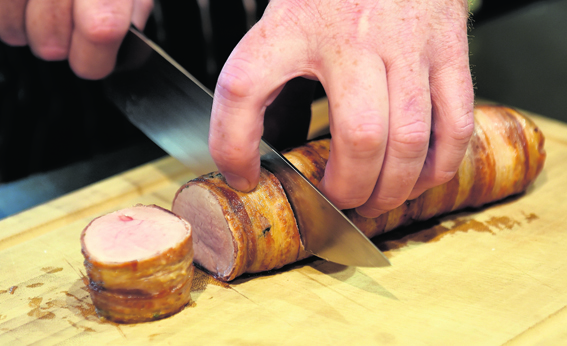 For the apples, scoop out the flesh with a melon baller or solferino scoop (like a melon baller but smaller). Tip out any oil from the pork pan and heat, add the apples and the stock and a little cider. Boil until reduced, scraping any crispy bits from the pan as these are full of flavour. Keep warm.
For the apples, scoop out the flesh with a melon baller or solferino scoop (like a melon baller but smaller). Tip out any oil from the pork pan and heat, add the apples and the stock and a little cider. Boil until reduced, scraping any crispy bits from the pan as these are full of flavour. Keep warm.
For the mash, cook peeled chopped potatoes until tender. Drain well, mash, then beat in 2tbsp milk, plenty of seasoning and a large knob of butter plus a handful of freshly chopped herbs. Serve on hot plates with your favourite veg, thick slices of the pork and a little gravy with the apples poured around.
ROLLED SHOULDER OF LAMB WITH GREENS AND DAUPHINOISE POTATOES
SERVES 4
1.5kg whole boneless shoulder of lamb
Half a bottle of red wine
Carrots, diced
2 star anise
1tsp coriander seeds
100ml stock (chicken or lamb)
1tsp black peppercorns
2 large onions, peeled and chopped
Quarter head of celery, chopped
2 bay leaves
2tbsp parsley, chopped
FOR THE GREENS
Mix of chard and kale
Olive oil
Salt and pepper
Open the shoulder of lamb out. Mix half a bottle of red wine and
35ml water, plus the star anise and coriander seeds in a dish
large enough for the meat. Add the meat and leave to marinate overnight.
The next day, heat the oven to 140C. Roll the shoulder up and tie tightly with string to keep a neat tube shape. Now place the celery, onion, bay leaves and peppercorns in an oven proof dish or meat tray. Place the tied meat on top and pour over half of the marinade plus 75ml stock (chicken or lamb). Put this in the oven for 2 hours.
Once cooked, take out of the liquid and leave for half an hour to cool. Remove the string and roll up with heatproof clingfilm into a tight sausage, twisting each end to make it very tight. Puncture this so that the liquid can escape, but keep it tight. Place in the fridge for a couple of hours to set. Strain the cooking liquid and place in a saucepan; this is your gravy.
When you’re ready to prepare the meal, remove the meat from the fridge and slice into 10cm rounds. Heat the gravy and braise each piece in it to heat through, adding a few diced carrots. Use the remaining gravy to drizzle over each portion, with a few carrots and a sprinkle of parsley.
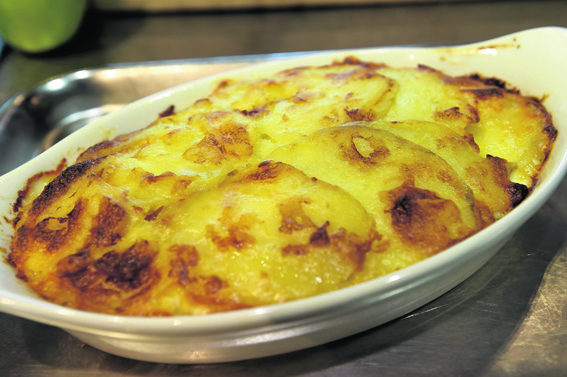 Serve on hot plates with your favourite potatoes – we made dauphinoise potatoes (find Nick’s dauphinoise recipe at www.nicknairn.com), and stir-fried greens.
Serve on hot plates with your favourite potatoes – we made dauphinoise potatoes (find Nick’s dauphinoise recipe at www.nicknairn.com), and stir-fried greens.
